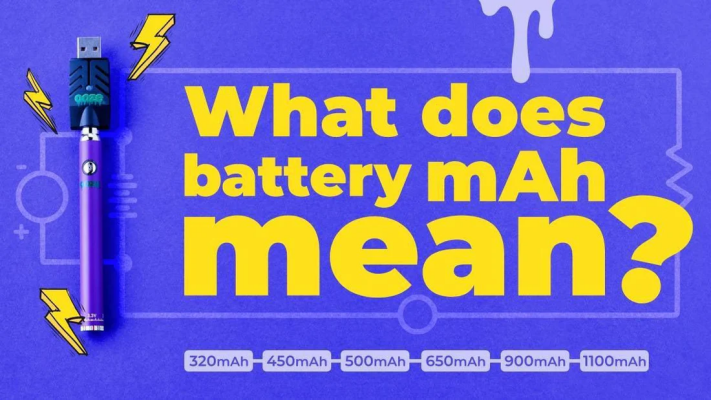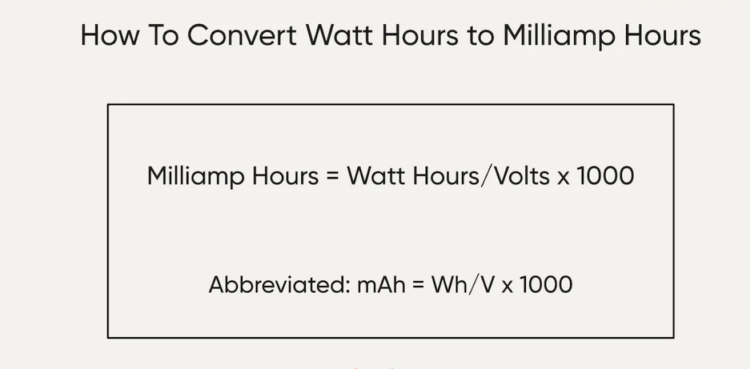OUTLINE:
Understanding mah - The Basics of Battery Capacity
 320
320In the pulsating heart of our tech-savvy world, where every device is a beacon of innovation, one enigmatic acronym reigns supreme: mAh.

Image Source: oozelife
But what does milliampere-hour (mAh) truly stand for, and why should you care? Prepare to be captivated as we unravel the electrifying mystery behind this essential unit, shedding light on its crucial role in energizing the devices we can't live without.
Join us on a journey of discovery, where knowledge sparks excitement and understanding illuminates the path to technological enlightenment.
Detailed Answer: What Does MAH Stand for
Here comes the answer:
"M" stands for "milli," which is a prefix denoting one-thousandth of a unit in the metric system. "A" stands for "ampere," which is the unit of electrical current. "H" stands for "hour," a unit of time.
So, when combined, "mAh" stands for "milliampere-hour," which is a unit used to measure the amount of electrical charge a battery can store and how long it can provide a certain level of current before needing to be recharged.
It's a common unit of measurement for the capacity of batteries, especially in portable electronic devices like smartphones, tablets, and laptops.
Key Concepts of MAH: Building Blocks for Beginners
Key Concepts of mAh (Milliampere-Hour) for Beginners:
1. Electrical Charge: mAh represents the amount of electrical charge a battery can store. Understanding this helps beginners grasp the battery's capacity in terms of how much energy it can hold.
2. Unit Prefixes: "Milli" denotes one-thousandth of a unit. In the case of mAh, it signifies a fraction of an ampere-hour, making it a manageable unit for measuring battery capacity.
3. Current and Time: The 'A' in mAh stands for "ampere," the unit of electrical current, while 'H' stands for "hour," a measure of time. Combining these elements highlights the battery's ability to deliver a certain level of current over a specified period.
4. Battery Capacity: mAh is a standard measure for battery capacity, indicating how long a battery can sustain a specific level of current discharge before needing recharging. Beginners should grasp this concept to evaluate the performance and endurance of different batteries.
5. Application in Devices: Understanding mAh helps beginners make informed decisions when selecting batteries for electronic devices. Higher mAh ratings generally indicate longer battery life, but factors like device efficiency and usage patterns also influence performance.
6. Importance of Efficiency: While higher mAh ratings suggest greater battery capacity, it's essential for beginners to recognize that battery efficiency and device optimization also play crucial roles in determining overall battery life.
Practical Examples: Illustrating its Usage in Everyday Scenarios
-
Smartphone Batteries
Consider two smartphones with batteries rated at 3000mAh and 4000mAh, respectively.
The device with the higher mAh rating is expected to last longer on a single charge under similar usage conditions, making it preferable for users who require extended battery life, such as heavy phone users or travelers.
-
Power Banks
When selecting a power bank for charging electronic devices on the go, understanding mAh is crucial. A power bank with a higher mAh rating can store more energy and charge devices multiple times before needing to be recharged itself.
For example, a 10,000mAh power bank can charge a smartphone with a 3000mAh battery approximately three times before requiring a recharge.
-
Laptop Batteries
Laptop batteries often have mAh ratings ranging from 3000mAh to 6000mAh or higher, depending on the model.
Higher mAh batteries offer longer usage times between charges, providing users with increased productivity and flexibility, especially in situations where access to power outlets is limited.
-
Flashlights
Rechargeable flashlights often come with batteries rated in mAh to indicate their capacity and runtime. A flashlight with a higher mAh battery can provide longer illumination before requiring recharging, making it suitable for outdoor activities or emergency situations where extended use is necessary.
-
Wireless Earbuds
Many wireless earbuds come with portable charging cases equipped with built-in batteries rated in mAh.
A higher mAh rating in the charging case allows for more charging cycles for the earbuds before the case itself needs to be recharged, ensuring users can enjoy their music or podcasts without interruption for longer periods.
Is A Higher MAH Battery Better
Have you ever thought of this question while selecting batteries? If not,here's the answer:
When considering batteries, the question often arises: is a higher mAh (milliampere-hour) rating better?
While a higher mAh rating typically indicates a battery with greater capacity to store energy, whether it's "better" depends on the context and individual needs.
In many cases, higher mAh batteries offer longer runtime between charges, which can be advantageous for devices requiring extended usage, such as smartphones, laptops, or portable electronic gadgets.
However, there are trade-offs to consider. Higher capacity batteries tend to be larger and heavier, which may impact portability and device design.
Additionally, higher mAh batteries often come with longer charging times, as they require more energy to replenish.
Therefore, the suitability of a higher mAh battery depends on balancing factors like battery life, device size and weight, and charging convenience based on the specific requirements and preferences of the user.
Ultimately, while a higher mAh battery may offer extended runtime, it's essential to weigh the pros and cons to determine whether it aligns with your priorities and usage patterns.

All in all,it is crucial to clarify the relationship between mah and wh. And It is equally important to learn to understand mah and wh of lithium batteries.
Commonly, mah indicates the battery's charge capacity, describing how much current it can deliver over time.
Higher mah ratings suggest longer device operation before needing a recharge. This is crucial for users who prioritize extended usage between charges, such as smartphone users.
Who represents the total energy capacity of the battery, factoring in both voltage and charge. It offers a comprehensive view of the battery's capability to deliver power.
Devices like laptops and electric vehicles often prioritize Wh ratings due to their reliance on sustained energy delivery.
When assessing lithium batteries, considering both mAh and Wh ratings is essential. Users should align their choice with their specific needs: mAh for prolonged device usage and Wh for overall energy capacity.
This understanding empowers users to make informed decisions, ensuring optimal performance and efficiency for their devices.
Final Verdict
Milliampere-hour (mAh) is a crucial unit of measurement representing the capacity of a battery to store electrical charge and deliver a specific level of current over time.
It serves as a standard metric for assessing the endurance and performance of batteries in various electronic devices, including smartphones, laptops, power banks, and more.
While a higher mAh rating generally implies longer battery life, it's essential to consider factors such as device efficiency, size, weight, and charging times when determining the optimal battery for your needs.
Understanding mAh empowers consumers to make informed decisions, ensuring their devices meet their usage requirements while balancing considerations of portability and convenience.
Thus, mAh stands as a fundamental concept in the world of electronics, guiding users towards enhanced efficiency and satisfaction in their technological experiences.

Disclaimer: The views and opinions expressed by individual authors or forum participants on this website do not represent the views and opinions of Chipsmall, nor do they represent Chipsmall's official policy.

share this blog to:

